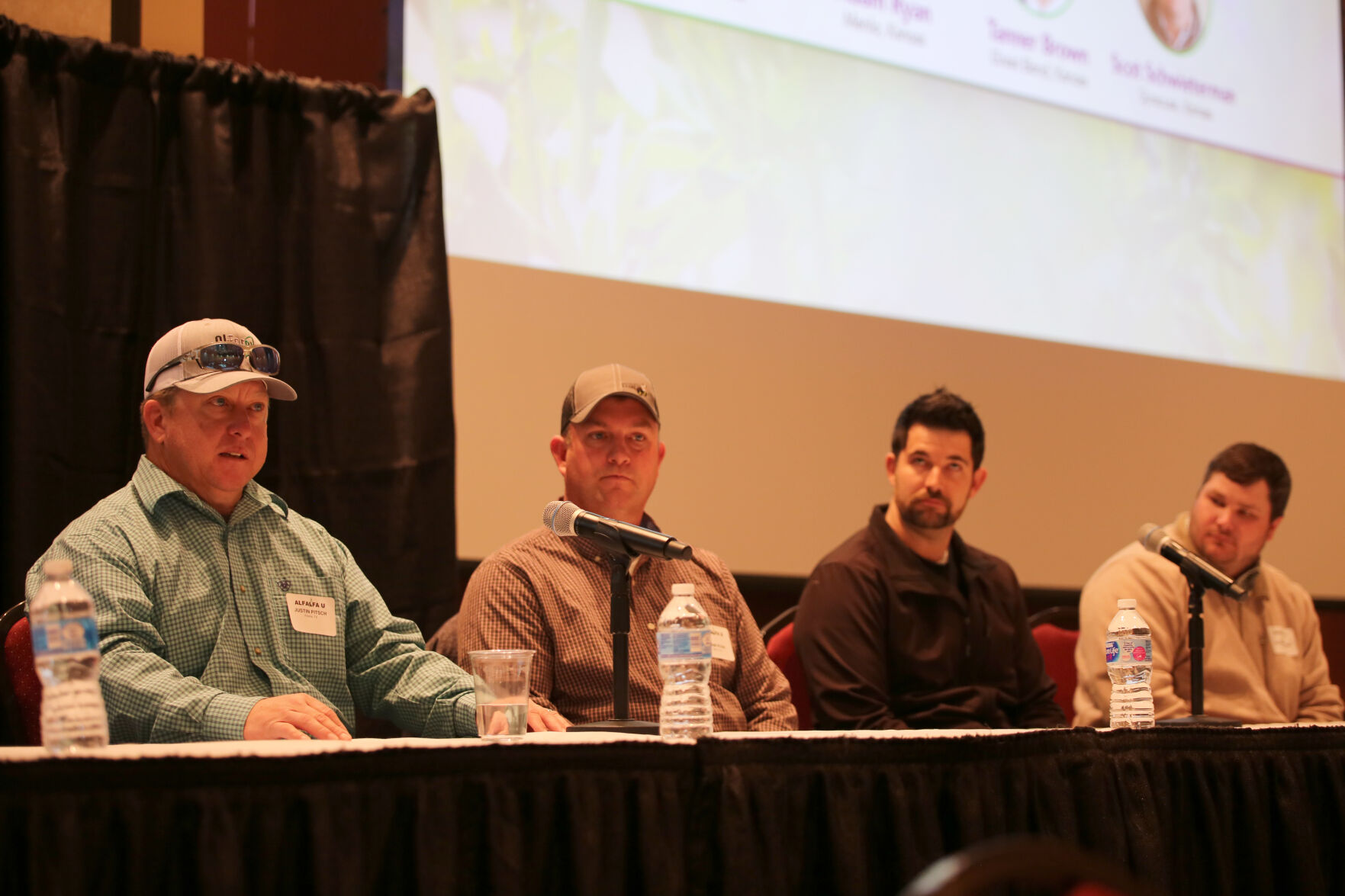Region sees different challenges for panelists at Dodge City Alfalfa U

The four farmer panelists at Alfalfa U in Dodge City, Feb. 22 come from varying regions across Kansas and the Texas Panhandle, and each face challenges and triumphs when it comes to growing alfalfa.
Justin Pitsch manages 4,000 acres for Del Rio Dairy near Friona, Texas, where the operation milks about 8,000 cows. Typically his crew green chops the first two cuttings of alfalfa and when it gets too late in the season they’ll bale it.
“We really enjoy the benefits of green chopping alfalfa,” he said. “We have challenges just like everybody else.”
Pitsch uses pond water from the dairy to irrigate with along with an allotment of irrigation water. He’s also found picking the right variety to match his soil situation helps.
“We’ve really enjoyed the benefits that low lignin alfalfa and we’ve also found that that’s the cheapest way to get alfalfa from the field to the cows,” he said. “So all those things combined in the salt tolerance to yield the quality, being able to go later that really drives our decision making in the seed that we use.”
Adam Ryan who farms near Menlo, Kansas, said his operation doesn’t have near the water options available on his farm when compared to Pitsch and he struggles with having enough suitable acres to grow alfalfa. There’s not many acres in northwest Kansas dedicated to alfalfa production.
Farm ground has become expensive, and Ryan sees no solution to fighting this problem.
“I don’t know how you overcome this,” he said. “I guess write a bigger check. The only solution I come up with any more.”
Tanner Brown, Great Bend, Kansas, has been farming with his dad—raising alfalfa and grass—for a number of years.
“We’re mostly dryland, we do a little bit of irrigation,” he said. “And hay is all we do.”
Scot Schwieterman farms near the Kansas-Colorado state line in Hamilton County, and faces issues with drought conditions as well as issues with salt, high pH and phosphorus and calcium in soils.
“We have a hard time freeing up our nutrients,” he said.
Pitsch pays close attention to what’s going on in the soil on his circles and the water availability, along with the number of acres available to him to grow alfalfa.
“For me, because my only customer is a dairy farm, I have to bring quality to the cows,” he said. “So quality alfalfa equals milk and milk equals money.”
Pitsch continually faces the shrinking water supply, and feels as though the pond water is a blessing in disguise.
“I’m able to use that pond water on a crop that in our area’s kind of becoming obsolete because of the water,” he said. “I’m able to continue to grow alfalfa in our region, and we’re one of the only ones that still do. Having the ability to do that, I think separates us from other people in our region.”
Brown said one of his biggest challenges is Mother Nature. But because alfalfa has such a long growing season, he’s able to take advantage of her fickleness.
“If it’s dry now and it rains a lot mid-May, early June we’re still going to get a good crop,” he said. “We’re fortunate enough—our ground, it’s mostly dryland, but it’s good ground and grows good alfalfa. And every year is a different challenge.”
Sign up for HPJ Insights
Our weekly newsletter delivers the latest news straight to your inbox including breaking news, our exclusive columns and much more.
Brown worries about drought often, but he believes having too much rain for alfalfa is a much bigger problem. In 2019 he had nearly 45 inches of rain, and had issues with hay curing.
In Hamilton County, Schwieterman doesn’t have the luxury of 45 inches of rain. Water availability is a challenge he deals with daily.
“We can go punch a button and make it rain, but we’ve got to have some recharge,” he said.
When it comes to focusing on yield or quality, for Schwieterman, it is give or take.
Typically in his area, Schwieterman sees producers get anywhere from 3 to 6.5 tons an acre, but if they happen to catch a rainstorm, they can produce a little more tonnage, but overall quality is still high.
For Pitsch, he’s able to get high quality and high yields. In his area five cuttings are usually the norm, sometimes six. He’s normally somewhere between 7 and 8.5 tons an acre a year.
“But the quality has got to be there,” he said.
Ryan also strives to have both, and is trying to get as much tonnage as he can for the dairy.
“The way we achieve that is through a lot of soil samples and tissue samples and water management,” he said. “We do a lot of micronutrient packages on our alfalfa. We also believe in fungicide.”
For Brown, if he had to pick one over the other, he would go with quality.
“Quality alfalfa always sells and resells. So if you’ve got good stuff people want it,” he said. “It’s a lot easier when you have good hay to sell it. If you’ve got crap it’s pretty tough.”
Kylene Scott can be reached at 620-227-1804 or [email protected].



